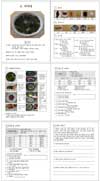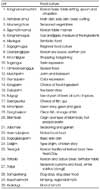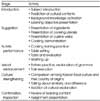Abstract
Objectives
The purpose of the study was to develop a textbook of the integrated education of Korean food culture and language for married female immigrants.
Methods
An analysis was conducted with the textbooks and researches for married female immigrants, and dietary life related contents were extracted. The contents were organized by activity oriented approach which is acquired the culture. The evaluation was conducted through depth interview with 6 married female immigrants through an analysis of the qualitative materials.
Results
The text book comprised of 30 Korean food recipes with the target expressions and vocabularies. It also included Korean basic table setting, Korean table manner, main dishes and side dishes, basic cutting, seasoning and garnish, measure of the ingredients, symbolic food, regional food culture, choice of food ingredients, shopping, bargaining, taste expression, color expression, all sorts of spices, Korean traditional festival food, and seasonal customs and food. For intensifying communication, activity which is close to real life was added. Through cooking, married female immigrants expose words and sentence patterns and that allows to evaluate their level of understanding. We observed that the developed textbook is suited for married female immigrants' needs and cognitive level. The text book included a comparative study between Korean culture and their country's culture, which could provide the motive for accepting each other’s cultures. The study showed how to develop a textbook that integrates Korean language education and Korean food culture and how to apply the textbook in real life.
Conclusions
The correct understanding about Korean food culture could lead to improvements communication ability. Useful information which relates to Korean food, recipes, and food culture could increase daily life satisfaction. Conducting both cultural education and language education could increase the participation of married female immigrants in learning activities. Therefore this study could help these females to adapt Korean society and manage family dietary life effectively.
Figures and Tables
References
1. Statistics Korea. 2015 Statistical year book of immigration service on foreign policy [internet]. Statistics Korea;2015. cited 2016 Apr 10. Available from: http://www.index.go.kr.
2. Lee CJ, Kim SG. Social networks and psychological adjustment of female foreign immigrants in Korea. Korean J Fam Welf. 2010; 15(4):73–91.
3. Park YS, Chung YS. Korean traditional food perception and cultural aspect of Korean Mongolian housewives. Korean J Food Cult. 2005; 20(1):35–43.
4. Asano K, Yoon JH, Ryu SH. Chinese female marriage immigrants' dietary life after immigration to Korea: comparison between Han-Chinese and Korean-Chinese. Korean J Community Nutr. 2014; 19(4):317–327.
5. Kim JH. A study on the dietary patterns affecting acculturation among marriage migrant women in urban area. J Korean Home Econ Educ Assoc. 2015; 27(4):173–189.
6. Cho HR. Teaching Korean culture in Korean language education for the beginning learners. J Korean Lang Educ. 2000; 11(1):153–173.
7. Lee MH. Teaching Korean through integrated language and culture: a teaching plan that considers integrating aspects of foreign language teaching and culture education. J Korean Lang Cult. 2004; 1(1):143–163.
8. Moon KH. A study on the contents of Korean cuisine vocabulary learning for female members of multi-cultural families. Lang Cult. 2013; 9(1):45–71.
9. Heo EH. A study of food words for female marriage immigrants. Lang Cult. 2012; 8(1):207–229.
10. Choi WS. A study on the social-cultural adaptation of foreign wives in Korea. J Asian Women. 2007; 46(1):141–181.
11. Kim JE, Kim JM, Seo SH. Nutrition education for female immigrants in multicultural families using a multicultural approach: In-depth interviews with female immigrants and nutrition education professionals. Korean J Nutr. 2011; 44(4):312–325.
12. Kang YJ, Jeong HS. A study on the awareness of traditional Korean food culture among immigrant housewives to design educational plans. Korean J Food Cult. 2013; 28(3):246–260.
13. Kim SH, Kim WY, Lyu JE, Chung HW, Hwang JY. Dietary intakes and eating behaviors of Vietnamese female immigrants to Korea through marriage and Korean spouses and correlations of their diets. Korean J Community Nutr. 2009; 14(1):22–30.
14. Kim JM, Lee NH. Analysis of the dietary life of immigrant women from multicultural families in the Daegu area. J Korean Diet Assoc. 2009; 15(4):405–418.
15. Lee JS. The factors for Korean dietary life adaptation of female immigrants in multi-cultural families in Busan. J Korean Soc Food Sci Nutr. 2012; 41(6):807–815.
16. Han YH, Shin WS, Kim JN. Influential factor on Korean dietary life and eating behaviour of female marriage migrants. Comp Korean Stud. 2011; 19(1):115–159.
17. Cho YA. A study on evaluation of food behavior and nutritional risks of Vietnamese female immigrants in Korea [master's thesis]. Kyunghee University;2010.
18. Park YI, Jeong HS, Joo NM. A study on multi-cultural family wives adapting to Korean cuisine and dietary patterns. Nutr Res Pract. 2010; 4(5):405–413.
19. National Institute of Korean Language. Korean with Marriage Immigrants 1. Seoul: Hangulpark;2010. p. 1–223.
20. National Institute of Korean Language. Korean with Marriage Immigrants 2. Seoul: Hangulpark;2010. p. 1–252.
21. Kang HH, Kim SJ, Hwang IG. Korean with Marriage Immigrants 3. Seoul: Hawoo Publishing;2011. p. 1–238.
22. Choi EG, Lee MH, Lee YS. Korean with Marriage Immigrants 4. Seoul: Hawoo Publishing;2011. p. 1–240.
23. Lee MH, Kang HH, Kim SJ, Choi EG, Kim HJ. Korean with Marriage Immigrants 5. Seoul: Hawoo Publishing;2012. p. 1–269.
24. Lee MH, Kang HH, Kim SJ, Choi EG, Kim HJ. Korean with Marriage Immigrants 6. Seoul: Hawoo Publishing;2012. p. 1–271.
25. Cho SK, Ko SH, Kim MA, Kim CJ, Woo IH, Woo CH, et al. My Mom's Korean Language. Seoul: Ministry of Agriculture;2007. p. 1–267.
26. Lee JH, Kim JS, An KH, Lee YS, Cho HY. Korean Language and Korean Culture elementary level 1. Seoul: Korean Immigration Service Foundation;2015. p. 1–208.
27. Lee JH, Kim JS, An KH, Lee YS, Cho HY. Korean Language and Korean Culture elementary level 2. Seoul: Korean Immigration Service Foundation;2015. p. 1–200.
28. Lee JH, Kim JS, An KH, Lee YS, Cho HY. Korean Language and Korean Culture intermediate level 1. Seoul: Korean Immigration Service Foundation;2015. p. 1–228.
29. Lee MH, Cho HR, Choi EG, Jeong MJ. Korean Language and Korean Culture intermediate level 2. Seoul: Korean Immigration Service Foundation;2015. p. 1–228.
30. Park HW, Moon ST. Analysis on the actual condition of female immigrants in rural area for social adjustment education. J Agric Educ Hum Resour Dev. 2008; 40(2):69–91.
31. Ju WR, Yang MH. A study on Korean cultural education needs of the immigrant women in Korea. J Korean Lang Cult. 2011; 8(1):175–203.
32. Suh KS. Delicious Korean 31. Seoul: Hankookmunwhasa;2011. p. 1–198.
33. Institute of Traditional Korean Food. The Beauty of Korean Food: with 100 Best. Seoul: Hollym;2008. p. 1–255.
34. Chang SY, Cho SJ. A Korean Mother's Cooking Notes. Seoul: Ewha Woman's University Press;2009. p. 1–198.
35. Korean Food Foundation. The Korean Kitchen. Seoul: Korean Food Foundation;2015. p. 1–201.
36. Lee HJ. A study on the effect of making happiness group program: qualitative approach. Korean J Qual Res Soc Welf. 2016; 10(1):55–75.
37. Joo ES, Kim JY. An exploratory study on the effect of focusing group program for the elderly with depression based on the focus group interview. J Korean Gerontol Soc. 2012; 32(2):611–629.
38. DietNet. Formation of Food Culture [internet]. The Korean Society of Community Nutrition;2016. cited 2016 Oct 20. http://www.dietnet.or.kr.
39. Kim JS. International Model development of Korean Language Education (II). Seoul: National Institute of Korean Language;2011. p. 1–309.
40. Kim MA. A study on the teaching Korean education methodology through cooking activities: for immigrant married woman [master's thesis]. Kyungsung University;2012.
41. Choi ES, Lee YJ. Influence of the value perception with Korean food on food satisfaction, life satisfaction. Tour Res. 2014; 29(1):75–95.
42. Lee YH. The effects of pre-reading activities on Korean high school students' English reading comprehension. Korean J Appl Linguist. 2012; 28(3):197–230.
43. Williams CL, Berry JW. Primary prevention of acculturative stress among refugees: Application of psychological theory and practice. Am Psychol. 1991; 46(6):632–641.
44. Satia-Abouta J, Patterson RE, Neuhouser ML, Elder J. Dietary acculturation: Applications to nutrition research and dietetics. J Am Diet Assoc. 2002; 102(8):1105–1118.




 ePub
ePub Citation
Citation Print
Print











 XML Download
XML Download